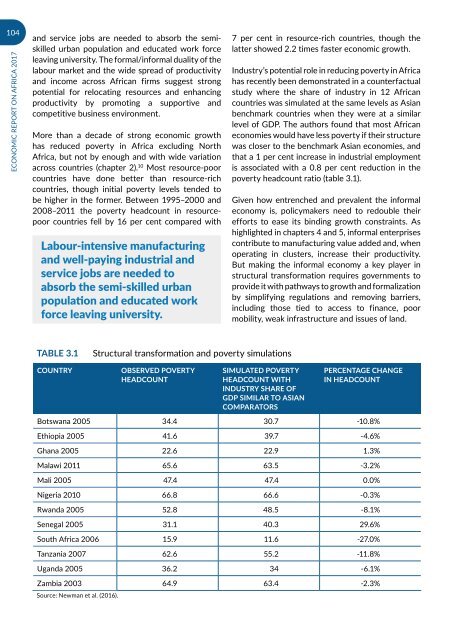URBANIZATION AND INDUSTRIALIZATION
Economic%20Report%20on%20Africa%202017%20UNECA
Economic%20Report%20on%20Africa%202017%20UNECA
You also want an ePaper? Increase the reach of your titles
YUMPU automatically turns print PDFs into web optimized ePapers that Google loves.
104<br />
ECONOMIC REPORT ON AFRICA 2017<br />
and service jobs are needed to absorb the semiskilled<br />
urban population and educated work force<br />
leaving university. The formal/informal duality of the<br />
labour market and the wide spread of productivity<br />
and income across African firms suggest strong<br />
potential for relocating resources and enhancing<br />
productivity by promoting a supportive and<br />
competitive business environment.<br />
More than a decade of strong economic growth<br />
has reduced poverty in Africa excluding North<br />
Africa, but not by enough and with wide variation<br />
across countries (chapter 2). 10 Most resource-poor<br />
countries have done better than resource-rich<br />
countries, though initial poverty levels tended to<br />
be higher in the former. Between 1995–2000 and<br />
2008–2011 the poverty headcount in resourcepoor<br />
countries fell by 16 per cent compared with<br />
Labour-intensive manufacturing<br />
and well-paying industrial and<br />
service jobs are needed to<br />
absorb the semi-skilled urban<br />
population and educated work<br />
force leaving university.<br />
7 per cent in resource-rich countries, though the<br />
latter showed 2.2 times faster economic growth.<br />
Industry’s potential role in reducing poverty in Africa<br />
has recently been demonstrated in a counterfactual<br />
study where the share of industry in 12 African<br />
countries was simulated at the same levels as Asian<br />
benchmark countries when they were at a similar<br />
level of GDP. The authors found that most African<br />
economies would have less poverty if their structure<br />
was closer to the benchmark Asian economies, and<br />
that a 1 per cent increase in industrial employment<br />
is associated with a 0.8 per cent reduction in the<br />
poverty headcount ratio (table 3.1).<br />
Given how entrenched and prevalent the informal<br />
economy is, policymakers need to redouble their<br />
efforts to ease its binding growth constraints. As<br />
highlighted in chapters 4 and 5, informal enterprises<br />
contribute to manufacturing value added and, when<br />
operating in clusters, increase their productivity.<br />
But making the informal economy a key player in<br />
structural transformation requires governments to<br />
provide it with pathways to growth and formalization<br />
by simplifying regulations and removing barriers,<br />
including those tied to access to finance, poor<br />
mobility, weak infrastructure and issues of land.<br />
Table 3.1<br />
Structural transformation and poverty simulations<br />
COUNTRY<br />
OBSERVED POVERTY<br />
HEADCOUNT<br />
SIMULATED POVERTY<br />
HEADCOUNT WITH<br />
INDUSTRY SHARE OF<br />
GDP SIMILAR TO ASIAN<br />
COMPARATORS<br />
PERCENTAGE CHANGE<br />
IN HEADCOUNT<br />
Botswana 2005 34.4 30.7 -10.8%<br />
Ethiopia 2005 41.6 39.7 -4.6%<br />
Ghana 2005 22.6 22.9 1.3%<br />
Malawi 2011 65.6 63.5 -3.2%<br />
Mali 2005 47.4 47.4 0.0%<br />
Nigeria 2010 66.8 66.6 -0.3%<br />
Rwanda 2005 52.8 48.5 -8.1%<br />
Senegal 2005 31.1 40.3 29.6%<br />
South Africa 2006 15.9 11.6 -27.0%<br />
Tanzania 2007 62.6 55.2 -11.8%<br />
Uganda 2005 36.2 34 -6.1%<br />
Zambia 2003 64.9 63.4 -2.3%<br />
Source: Newman et al. (2016).


